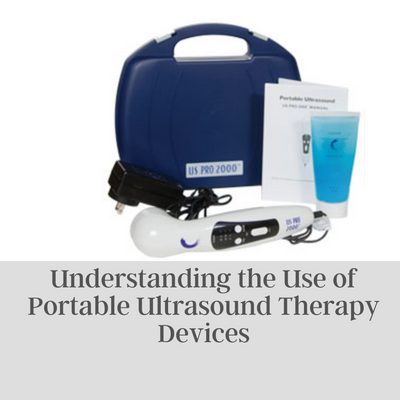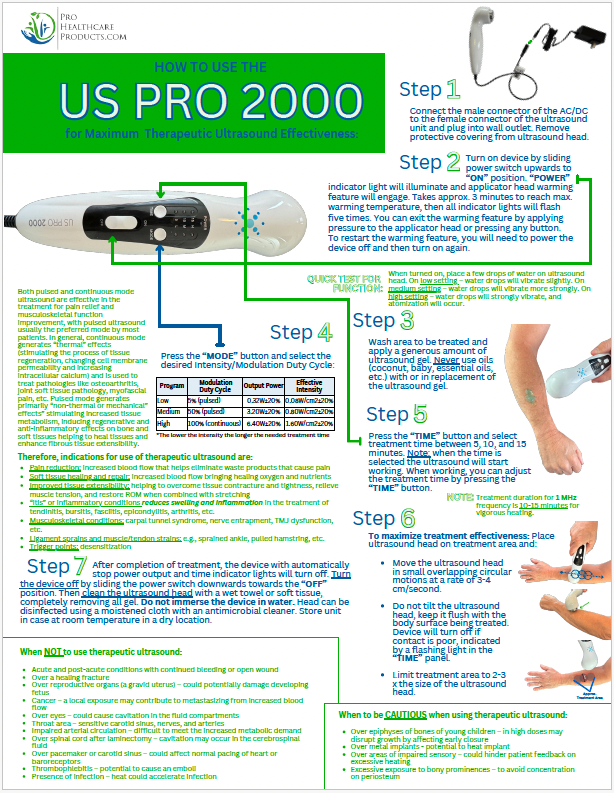 30th Apr 2021
30th Apr 2021
Understanding the Use of Portable Ultrasound Therapy Devices
What is Ultrasound?
Ultrasound is a form of acoustic, or sound, energy and the
name used to describe mechanical pressure sound waves that are acting at such a
high frequency that they cannot be detected by human ears.
How are the Ultrasound Waves Generated?
Ultrasound waves are produced when an alternating electrical current is impressed on a piezoelectric ceramic crystal (located in the head or transducer of the ultrasound wand) which causes it to vibrate, producing mechanical waves identical to sound waves. As these sound waves travel through a required medium (ultrasound gel) they compress (called the condensation phase characterized by increased molecular density) and release (called the rarefaction phase characterized by decreased molecular density) the molecules of the medium and impart energy to the gel. The energy from the generated sound waves may produce thermal (heat) or mechanical (deformation or vibration of molecules) effects where they are absorbed in human tissue.
What is Ultrasound Therapy and What is it Used to Treat?
Ultrasound is a therapeutic modality used to treat musculoskeletal conditions. The high-frequency ultrasound waves are delivered to the body tissue in a well-collimated cylindrical beam that focuses the energy to targeted tissues. The physical principles of ultrasound – the acoustical vibrational/mechanical energy of the sound waves and the transmission and absorption of ultrasound energy (thermal-heat) in soft tissues – are used to:
- Reduce pain
- Decrease inflammation
- Increase soft tissue extensibility and flexibility
- Improve joint range of motion
- Facilitate soft tissue repair and wound healing
|
Indications for Use of Therapeutic Ultrasound
|
|
Contraindications for Use of Therapeutic Ultrasound
|
What are the Characteristics of the Ultrasound Wave and How Does this Effect Treatment Settings?
Frequency: Defined as the number of oscillations a molecule undergoes during 1 second and is measured in hertz. 1 Hz = 1 cycle/second. Therapeutic ultrasound soundwaves can be delivered at different frequencies, which affects the depth of tissue penetration and therefore the targeted tissue that can be treated.
- Frequency of 1 MHz (1 million cycles/second) = sound waves penetrate tissue more deeply at 2.5 to 5 cm (1 to 2 inches). This frequency should be used when target tissue is greater than 2 cm beneath the skin.
- Frequency of 3 MHz (3 million cycles/second) = sound waves are absorbed more easily and therefore penetrate less deeply at less than 2 cm (<1 inch). This frequency should be used when target tissue is 1 to 2 cm from the body surface.
Mode: Ultrasound energy waves can be delivered in an uninterrupted flow (referred to as continuous) or at periodic intervals (referred to as pulsed).
- Continuous Mode: The ultrasound energy is delivered continuously and is associated with producing a heating effect.
- Pulsed Mode: The ultrasound energy is delivered in bursts with an “on” and “off” time. During the “off” time the heat that was generated dissipates so that the mechanical effects are enhanced. The “on” time in relationship to the total of the “on” and “off” times is expressed as a duty cycle. Most ultrasound machines have duty cycles ranging between 10% to 50%, with the greater tissue effects occurring with duty cycles of 20% to 50%.
Intensity: The strength or output power of the ultrasound wave is a measure of the quantity of energy produced by the ultrasound transducer (piezoelectric crystal) and is measured or expressed in watts per centimeter squared (w/cm2). A safe range of intensity for a moving ultrasound wand transducer/head is considered to be 0.5 to 3.0 W/cm2.
The effective radiating area (ERA) of a transducer is a measure of the actual cross-sectional area of the ultrasound beam as it exits the metal end plate of the ultrasound wand and is expressed in square centimeters (cm2). An ultrasound head/transducer of 1 cm2 would be used to treat a smaller area, while an ultrasound head/transducer of 5 cm2 would cover a larger area.
It should be noted that with most current ultrasound machines the total output is within regulatory standards.
Some General Guidelines for Administering Ultrasound Therapy
- 1.Always ensure that the skin over the area to be treated has proper skin sensation.
- 2.The treatment area should not exceed 2 to 3 times the size of the ERA of the transducer. Select the appropriate transducer size – a small (1 cm2) transducer is designed for a small local area.
- 3.Select an appropriate treatment frequency range - 3MHz should be used for more superficial tissue targets, while sound waves of 1 MHz are more appropriate for deeper tissue targets.
- 4.Use an appropriate coupling agent (ultrasound gel) to transmit the sound waves to the body.
- 5.Keep the wand/transducer head in constant contact with the skin and moving over the skin at a rate of about 4.0 cm/second. Move the transducer/head in a circular pattern with each circle covering about ½ the area of the previous circle.
- 6.Set the ultrasound characteristics according to
the parameters for the desired outcome. Generally to:
- Increase metabolism and reduce mild inflammation: Doses that increase tissue temperature 1° C
- Reduce pain, increase blood flow, and reduce muscle spasm: Doses that increase tissue temperature 3.5° to 5.5° C
- Increase tissue extensibility and enhance range of motion: Doses that increase tissue temperature 4 ° C

- 7.Duration of treatment time is usually 5 to 15 minutes depending on desired therapeutic outcome.
The Different Portable Ultrasound Machines Sold by ProhealthcareProducts.com.
SoundCare Plus Ultrasound (DQ9275) device is primarily a prescription recommended machine where a therapist recommends to their patient that they obtain the machine and then report to the clinic where the patient is shown by the therapist its proper use and the ultrasound parameters (total dosage) for their specific musculoskeletal condition.
- The "20 Preset Programs" with this machine are various settings where the frequency (1 or 3 MHz), Mode (Continuous Wave or Pulsed), Intensity (Watts/cm2) and Duration (# minutes of treatment time) are randomly assigned primarily to occupy the set positions (1, 2, . . . 20) so that the therapist can personally program the device treatment options according to their professional preference. Note: Many patients take this unit to their therapist so he/she can program the settings specific to the patient’s condition.
Click HERE for the Soundcare Plus
Ultrasound device user manual
Current Solutions US 1000 (CS-DU1025) and the Current Solutions Pro 2000 (CS-DU3035) Ultrasound Machines. Both machines are powered by AC/DC adapter, have a 5 cm transducer head, operate at a frequency of 1 MHz only, and provide three easy to use preprogrammed settings – Low, Medium, and High – with duty cycles of 30%, 40%, and 50% respectively. Ultrasound gel is also included with each device. The differences between the US 1000 unit and the Pro 2000 unit are that the Pro 2000 unit is a newer model with these additional features:
A "pre-heat" feature so that the ultrasound head is warm vs cold when applied to the patient.
The wand is ergonomically designed for comfortable fit to the hand so there is less stress in holding it compared to the other unit's wand design.
The timer allows you to select 5-, 10-, and 15-minute treatment times with the push of a button, and the duty cycle buttons are set at 30%, 40% and 50% respectively.
Click HERE for the Current Solutions US 1000 ultrasound device user manual
Click HERE for the Current Solutions
Pro 2000 ultrasound device user manual
Step By Step Guide to How to Use the Pro 2000 Ultrasound:
UltraTENS II Portable Ultrasound and TENS Combo Device
This combo device includes the therapeutic modalities of ultrasound and transcutaneous electrical nerve stimulation (TENS) for a two-fold attack against chronic pain. This device comes with an ergonomically designed 4 cm2 aluminum soundhead, features 1 MHz with 3 power levels for easy use, and 30 mA of TENS for deep therapeutic treatment, and ultrasound gel.
Click HERE for the UltraTENS II Portable Ultrasound and TENS Combo Device user manual
Ultrasound Gel Product Options
Ultrasound gel is applied to the body part that will receive the ultrasound. The gel is essential to transmit the sound waves from the ultrasound head or transducer to the body. ProhealthcareProducts.com offers a variety of ultrasound gel/lotion sizes from individual bottles to larger containers depending on your specific needs. They are:
- Therasonic Conductive Ultrasound Gel – 8oz. bottle (Click HERE to purchase)
- Therasonic - Conductive Ultrasound Gel – 16oz. bottle (Click HERE to purchase)
- Chattanooga Conductor Ultrasound Gel – 8.5oz. bottle (Click HERE to purchase)
- Dynatron Ultrasound Lotion – 1 gallon (Click HERE to purchase)
- Mettler Sonigel Ultrasound Lotion with Aloe Vera – 1 gallon (Click HERE to purchase)
- DynaGel Ultrasound Gel Blue – 5 liter cube container shipped with one empty 8 oz. bottle (Click HERE to purchase)
In addition, ProhealthcareProducts.com sells ultrasound gel bottle warmers. They are:






